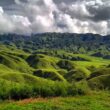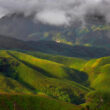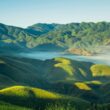Monument Valley Navajo Tribal Park is a breathtaking natural wonder located in the heart of the Navajo Nation in the American Southwest. With its towering red rock formations and sweeping vistas, it has become one of the most popular tourist destinations in the region. In this article, we will explore the history, geology, and culture of Monument Valley, as well as provide tips for visitors to make the most of their trip.
History
The history of Monument Valley dates back thousands of years. The Navajo people have lived in the region for centuries and consider it to be a sacred site. They believe that the towering rock formations were created by the gods to provide protection and shelter for their people.
In the late 19th century, European settlers began to move into the area, bringing with them mining and cattle ranching operations. This led to conflicts with the Navajo, who were forced onto reservations and suffered under oppressive policies enacted by the U.S. government.
In the early 20th century, Monument Valley began to attract attention from artists and filmmakers. In 1938, director John Ford came to the area to film the Western movie “Stagecoach,” starring John Wayne. This began a long tradition of using Monument Valley as a backdrop for movies and TV shows, including “The Lone Ranger,” “The Searchers,” and “Forrest Gump.”
Geology
The geology of Monument Valley is unique and fascinating. The towering rock formations are the result of millions of years of erosion and geological activity. The valley is situated on the Colorado Plateau, which is a large area of uplifted rock that spans parts of Arizona, Utah, Colorado, and New Mexico.
The rocks of Monument Valley are primarily sandstone, which was deposited in the region during the Jurassic period, around 200 million years ago. Over time, the sandstone was lifted and tilted, and then eroded by wind and water, creating the distinctive formations that we see today.
The most famous rock formations in Monument Valley are the Mittens and Merrick Butte. The Mittens are two towering spires that rise up from the valley floor, while Merrick Butte is a large mesa that overlooks the valley.
Culture
The Navajo people have a deep connection to Monument Valley and consider it to be a sacred site. They have lived in the region for centuries and have developed a rich cultural heritage that is still alive today.
Visitors to Monument Valley can learn about Navajo culture through guided tours and cultural experiences. Many of the tour guides are Navajo themselves, and they can provide insights into the history, mythology, and spirituality of the region.
One of the most popular cultural experiences is a traditional Navajo meal, known as a “Navajo taco.” This dish consists of frybread topped with ground beef, beans, lettuce, tomatoes, cheese, and salsa. Visitors can also watch demonstrations of traditional Navajo crafts, such as weaving and pottery-making.
Visiting Monument Valley
Monument Valley is open year-round, but the best time to visit is in the spring and fall, when temperatures are mild and the crowds are smaller. The summer months can be very hot, and winter can bring snow and ice, making driving conditions hazardous.
There are several ways to explore Monument Valley, including guided tours, self-guided tours, and hiking. The most popular way to see the valley is by taking a guided tour. These tours are led by Navajo guides and take visitors to some of the most iconic locations in the park, such as the Mittens and Merrick Butte.
Visitors can also drive the 17-mile scenic loop road, which provides stunning views of the valley from various angles. The road is unpaved, so a four-wheel-drive vehicle is recommended. Hiking is also an option, but visitors should be aware that the trails can be challenging and require a good level of fitness and preparation.
When planning a trip to Monument Valley, there are a few things to keep in mind. First, the park is located on Navajo Nation land and is managed by the Navajo Parks and Recreation Department. Visitors will need to purchase a parking pass to enter, which costs $20 per vehicle for up to four people. Additional passengers cost $5 each. The pass is valid for four days.
Second, there are limited amenities in the park, so visitors should come prepared with food, water, and other supplies. There is a small visitor center that offers snacks and souvenirs, but it is not a full-service facility.
Third, visitors should respect the culture and traditions of the Navajo people. This includes following any rules and regulations set forth by the park, such as not climbing on or touching the rock formations, and not disturbing any artifacts or cultural sites.
Conclusion
Monument Valley Navajo Tribal Park is a truly unique and awe-inspiring destination that offers visitors a glimpse into the rich history and culture of the Navajo people. With its towering red rock formations, sweeping vistas, and fascinating geology, it is a must-see for anyone traveling through the American Southwest.
Whether you choose to take a guided tour, drive the scenic loop road, or go hiking, there are plenty of ways to explore the park and experience its beauty firsthand. Just remember to come prepared, respect the culture and traditions of the Navajo people, and take the time to appreciate the natural wonders that surround you.
Similar Articles
Frequently Asked Questions About Monument Valley Navajo Tribal Park
- What is Monument Valley Navajo Tribal Park?
Monument Valley Navajo Tribal Park is a natural wonder located in the heart of the Navajo Nation in the American Southwest. It is known for its towering red rock formations and sweeping vistas and has become a popular tourist destination.
- What is the history of Monument Valley?
Monument Valley has a rich history that dates back thousands of years. The Navajo people have lived in the region for centuries and consider it to be a sacred site. European settlers began to move into the area in the late 19th century, bringing with them mining and cattle ranching operations. This led to conflicts with the Navajo, who were forced onto reservations and suffered under oppressive policies enacted by the U.S. government. In the early 20th century, Monument Valley began to attract attention from artists and filmmakers and has since been used as a backdrop for many movies and TV shows.
- What is the geology of Monument Valley?
The geology of Monument Valley is unique and fascinating. The valley is situated on the Colorado Plateau, which is a large area of uplifted rock that spans parts of Arizona, Utah, Colorado, and New Mexico. The rocks of Monument Valley are primarily sandstone, which was deposited in the region during the Jurassic period, around 200 million years ago. Over time, the sandstone was lifted and tilted, and then eroded by wind and water, creating the distinctive formations that we see today.
- What is the culture of Monument Valley?
The Navajo people have a deep connection to Monument Valley and consider it to be a sacred site. They have lived in the region for centuries and have developed a rich cultural heritage that is still alive today. Visitors to Monument Valley can learn about Navajo culture through guided tours and cultural experiences. Many of the tour guides are Navajo themselves, and they can provide insights into the history, mythology, and spirituality of the region.
- How do I visit Monument Valley?
Monument Valley is open year-round, but the best time to visit is in the spring and fall when temperatures are mild and the crowds are smaller. There are several ways to explore Monument Valley, including guided tours, self-guided tours, and hiking. Visitors will need to purchase a parking pass to enter, which costs $20 per vehicle for up to four people. Additional passengers cost $5 each. Visitors should also come prepared with food, water, and other supplies, as there are limited amenities in the park.









